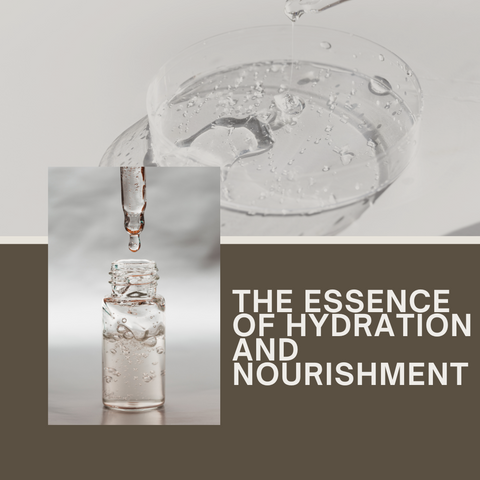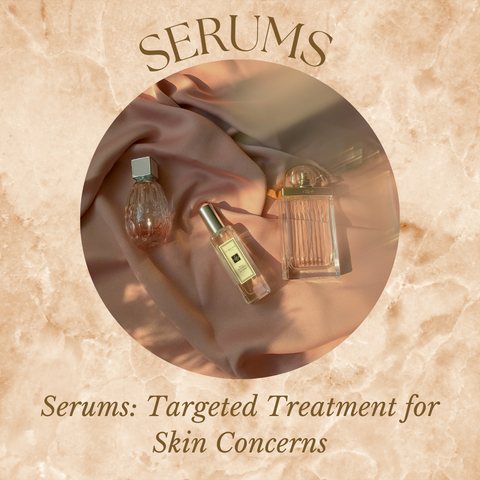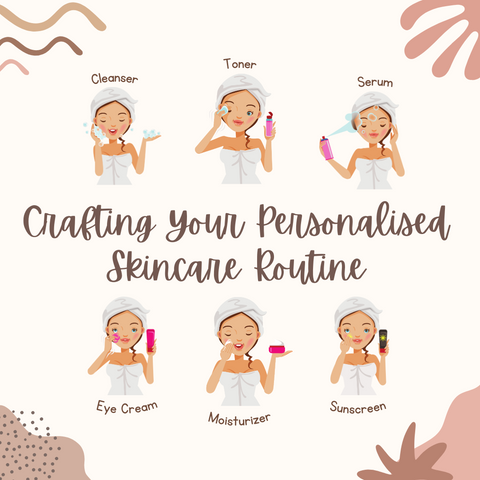Understanding the functions and differences of toners, essences, and serums in a skincare routine will help you optimise their use and benefits for healthier, more beautiful skin. For best results, adjust your routine based on your skin's reaction to these items.
Exploring the World of Facial Toners

Facial toners have progressed from their initial astringent purpose to become versatile solutions with a variety of benefits. In this blog, we will dig into the world of facial toners. When chosen carefully based on skin type and issues, facial toners can be a valuable complement to a skincare programme. Experimenting with different toners and finding the appropriate one for your skin might result in a more balanced and rejuvenated complexion.
The Role and Benefits of Toners in Skincare
Toners are essential components of skincare regimens, providing a variety of advantages that lead to healthier, more balanced skin. Toners play a variety of roles in skincare, including balancing pH levels, cleansing and removing residues, prepping the skin, hydration and refreshment, pore minimization and tightening, soothing and calming, exfoliating and skin rejuvenation, and oil and sebum control.
How to Use Toners:
-
After cleansing, apply a small amount of toner to a cotton pad or your hands.
-
Avoid touching or sweeping the toner near your eyes as you gently move it over your face and neck.
-
Before continuing with the remainder of your skincare regimen, give the toner time to completely absorb into the skin.
Including a suitable toner in your skincare routine can provide a variety of benefits, depending on the formulation and the needs of your skin. It can help to make skin clearer, more balanced, and hydrated, improving the effectiveness of subsequent skincare products.
Selecting a Toner for Your Skin Type
Choosing the best toner for your skin type entails taking into account particular qualities and components that cater to your skin's demands. Here's a guide on choosing the best toner for your skin type:
-
Dry Skin: Hydrating Ingredients: To add moisture, look for toners that contain hyaluronic acid, glycerin, or ceramides. Alcohol-free Formulas: Toners with a high alcohol content should be avoided as they can further dry out the skin. Key Concerns: Dehydration, flakiness, or tightness.
-
Oily/Acne-Prone Skin: Astringent Properties: If you want to reduce pores and control oil production, try using toners that contain witch hazel or salicylic acid. Non-comedogenic and oil-free: Choose oil-free, lightweight formulas that will not clog pores or make acne worse. Key Concerns: Excess oil, enlarged pores, acne, or blemishes.
-
Combination Skin: Balanced Formulas: Seek out toners that moisturise drier areas while balancing oiliness in the T-zone. Lightweight Texture: Opt for toners that do not cause a lot of residue or feel heavy on the skin. Key Concerns: Dry cheeks or other areas and an oily T-zone (forehead, nose, and chin).
-
Sensitive Skin: Gentle Formulations: To reduce irritation, choose hypoallergenic, alcohol-free, and fragrance-free toners. Composing Soothing Ingredients: To relieve and calm sensitive skin, look for toners that include calendula, chamomile, or aloe vera. Key Concerns: Sensitive to irritation and redness/inflammation.
-
Aging or Mature Skin: Anti-aging Ingredients: To reduce the appearance of wrinkles and enhance the texture of your skin, try using toners that contain antioxidants like vitamin C, peptides, or retinoids. Hydration Boost: To firm and plump up the skin, use toners that have hydrating qualities. Key Concerns: Fine lines, wrinkles, loss of elasticity, or uneven skin tone.
To achieve optimal results and preserve skin balance and health, choose a toner that is matched to your skin type and issues. Experimenting with different toners and understanding your skin's needs will help you identify the best toner for your skincare routine.
Toners: More Than Just Skin Cleansing
Toners now provide several skin-benefitting functions in addition to their conventional cleansing function. Here's a closer look at the benefits toners provide beyond just cleaning skin:
-
Restoring pH Balance: After cleansing, toners assist in restoring the skin's pH balance, which may have been upset by alkaline cleansers or soaps. The function of the skin barrier is supported by balanced pH levels.
-
Hydrating Properties: Hydrating components like hyaluronic acid, glycerin, or botanical extracts are found in a lot of contemporary toners. They are especially beneficial for dry skin types, as they help seal in moisture and avoid dehydration.
-
Skin Prep and Absorption: Toners maximise the skin's absorption of ensuing skincare products, such as serums, moisturisers, or treatments, by providing a clean, slightly exfoliated canvas.
-
Soothing Ingredients: Some toners contain soothing ingredients such as chamomile, aloe vera, or green tea extracts, which soothe irritation, redness, or sensitive skin.
-
Pore Tightening: Astringent toners or those containing witch hazel or tea tree oil can temporarily tighten pores, reducing their appearance and providing a smoother complexion.
-
Mild Exfoliation: Some toners contain AHAs (Alpha Hydroxy Acids) or BHAs (Beta Hydroxy Acids) that exfoliate gently, assisting in the removal of dead skin cells and promoting skin renewal.
-
Controlling Oil Production: In cases of oily or acne-prone skin, astringent toners can help reduce shine and stop breakouts by helping to regulate excess oil production.
-
Anti-inflammatory Effects: Certain toners contain anti-inflammatory components that can soothe irritated or acne-prone skin and lessen redness.
-
Refreshing Sensation: Toner application can give the skin a revitalising boost and feel energising and refreshing.
-
Benefits of Antioxidants: Antioxidant toners, such as those containing vitamins C and E, shield the skin from oxidative stress and free radical damage.
Modern toners come in a variety of formulations that cater to different skin types and concerns, and they provide a plethora of benefits in addition to basic cleansing. Incorporating the right toner into your skincare routine can help you achieve healthy, balanced, and radiant skin.
The Essence of Hydration and Nourishment

Hydration and nourishment are essential in skincare, particularly through the use of hydrating essences, for maintaining healthy, plump, and beautiful skin. Let's dig a little more into this:
-
Hydrating Essences: Hydrating essences are light, fluid compositions that contain concentrated moisture-binding substances such as hyaluronic acid, glycerin, or ceramides. They penetrate the skin deeply, offering powerful hydration to the deeper layers, plumping the skin, and increasing its moisture content.
-
Nourishment and Benefits: Botanical extracts, vitamins, and antioxidants are frequently found in essences, and they nourish the skin while promoting its health and vitality. Hydrating essences build the skin barrier by replenishing moisture and delivering critical nutrients, enhancing its resilience to environmental assaults.
-
Increased Absorption: Hydrating essences prepare the skin for following skincare products, maximising the efficacy of serums, moisturisers, or treatments.
-
Plumping and Radiance: The intense hydration provided by essences plump the skin, reducing the appearance of fine lines and providing a smoother, more youthful appearance. Improved hydration frequently results in a more radiant complexion, as the skin seems suppler and healthier.
-
How to Use Hydrating Essences: After cleaning and toning, use your hands or fingertips to gently pat the essence onto your skin. Essences can be layered for increased hydration, with numerous thin layers applied to achieve optimum absorption.
-
Choosing the Right Essence: When choosing an essence, consider your skin type and specific concerns, such as dryness, ageing, dullness, or sensitivity. Look for important elements such as hyaluronic acid, glycerin, niacinamide, or botanical extracts that are beneficial to your skin. Choose lightweight, fast-absorbing essences that are readily absorbed into the skin and do not leave a sticky residue.
What Makes Essences Unique
Essences distinguish themselves from other skincare products due to their unique compositions and benefits. Essences are distinguished by their lightweight consistency, high active ingredient concentration, deep penetration and absorption, hydration and nourishment, versatility, skin preparation, personalisation and layering, targeted solutions, multi-functionality, and suitability for a wide range of skin types. Essences stand out in the skincare routine due to their lightweight texture, high concentrations of therapeutic components, and deep skin penetration. Because of their ability to provide intense hydration, nourishment, and preparation for future products, they are an important step in creating healthy, glowing skin.
Incorporating Essences into Daily Skincare
Incorporating essences into your daily skincare routine entails understanding their role and how to use them optimally. Here's a step-by-step approach to efficiently incorporating essences, including cleaning, toning (optional), using the essence, frequency, customisation, layering, follow-up skincare, sun protection, adjustments, and monitoring.
Tips for Effective Use:
-
The key is consistency: use the essence frequently to reap its benefits gradually.
-
Choose the Right Essence: Look for an essence that has been specially formulated for your skin type and concerns, with an emphasis on ingredients that address your specific needs.
-
Patch Test: Before incorporating a new essence, perform a patch test to ensure there are no adverse reactions.
-
Patience for Results: Allow your skin to adjust to the essence, as skincare results can take time, and improvements may not be visible right away.
Essences for Different Skin Needs
Here's a breakdown of various essences designed to address specific skin concerns:
-
Hydrating Essences: These are great for dehydrated skin. They typically contain ingredients that deeply hydrate and plump the skin, such as hyaluronic acid, glycerin, or ceramides.
-
Brightening Essences: These products are designed to even out skin tone and reduce the appearance of dark spots or hyperpigmentation. They may contain ingredients such as vitamin C, niacinamide, or alpha arbutin, which help to brighten the skin.
-
Anti-Aging Essences: Designed to reduce fine lines and wrinkles while increasing collagen production. Anti-aging essences frequently contain peptides, retinol, or antioxidants such as green tea extract or vitamin E.
-
Balancing Essences: These essences help control excess oil production while maintaining hydration in combination or oily skin types. Ingredients such as salicylic acid, tea tree oil, or witch hazel can be used to regulate sebum and prevent breakouts.
-
Soothing or calming essences: Designed to soothe irritated or sensitive skin, these essences frequently contain ingredients such as aloe vera, centella asiatica (Cica), chamomile, or oat extract to reduce redness and inflammation.
-
Firming Essences: Designed to increase skin elasticity and firmness. These essences frequently contain ingredients that help tighten the skin, such as collagen, peptides, or elastin.
-
Exfoliating Essences: These products typically contain mild exfoliating agents such as AHAs (alpha hydroxy acids) or BHAs (beta hydroxy acids) to gently remove dead skin cells, unclog pores, and improve skin texture.
When selecting an essence, keep your skin type and specific concerns in mind. Patch testing new products is also advised to avoid negative reactions, particularly for people with sensitive skin. Furthermore, integrating essences into a skincare routine after cleansing and before heavier serums or moisturisers can improve their efficacy.
Serums: Targeted Treatment for Skin Concerns

Serums are concentrated solutions with significant active ingredients that are designed to tackle specific skin issues. Here's a rundown of serums designed to address specific skin concerns:
-
Hyaluronic Acid Serums: These serums are great for hydrating and plumping the skin. Hyaluronic acid attracts moisture to the skin, making it an excellent choice for dehydrated skin of all types.
-
Vitamin C Serums: Known for their brightening properties, vitamin C serums help even out skin tone, fade dark spots, and protect the skin from free radical damage caused by environmental stressors like UV rays and pollution.
-
Retinol Serums: These serums are effective for addressing ageing signs such as fine lines, wrinkles, and uneven skin texture. Retinol stimulates cell turnover and collagen production, resulting in smoother, younger-looking skin. It's essential to start with a lower concentration and gradually increase it to avoid irritation.
-
Niacinamide serums: Helpful for several skin issues, such as minimising the appearance of enlarged pores, controlling oil production, and enhancing uneven skin tone. The calming and anti-inflammatory effects of niacinamide are well-known.
-
Peptide Serums: Peptides are amino acids that promote the synthesis of collagen, resulting in skin that is firmer and more resilient. Peptide serums have the potential to improve overall skin health and lessen the appearance of wrinkles.
-
Glycolic acid or Alpha Hydroxy Acid (AHA) Serums: These serums include glycolic acid and other alpha hydroxy acids (AHAs), which exfoliate the skin, clear clogged pores, and enhance skin texture by removing dead skin cells. They are effective in treating mild discoloration, fine lines, and dullness.
-
BHA or salicylic acid serums: Perfect for oily or acne-prone skin types, as salicylic acid deeply cleans pores and lessens the frequency of breakouts. It works well for treating whiteheads and blackheads as well as reducing excessive oil production.
-
Antioxidant Serums: These serums help to neutralise free radicals and provide protection against environmental damage. They often contain ingredients like resveratrol, green tea extract, and vitamin E.
To optimise the absorption of the active ingredients in a serum, it is imperative to apply the serum to cleansed skin before using a moisturiser. Additionally, it is imperative to wear sunscreen during the day, particularly if you are using serums that contain exfoliating or photo-sensitizing ingredients to ward off sun damage. Tailoring your serum selection to your skin type and concerns can result in more effective results when it comes to addressing specific skincare needs.
Understanding the Potency of Serums
Understanding serum potency entails taking into account a number of factors, including active ingredient concentration, formulation, and intended purpose. Here are some key points to consider when evaluating serum potency:
-
Concentration of Active Ingredients: The potency of a serum is frequently determined by the concentration of active ingredients it contains. Higher concentrations generally indicate greater efficacy, but they can also increase the risk of irritation, particularly in those with sensitive skin. For example, a serum containing 10% vitamin C may be milder than one containing 20%, but it may still provide visible results over time.
-
pH and Formulation: The pH of a serum can have an effect on its potency and effectiveness. Some active ingredients necessitate a specific pH range in order to be stable and effective. Furthermore, the serum's formulation, including the combination of ingredients and their delivery systems, can influence how well the active ingredients penetrate the skin.
-
Product Stability: The potency of active ingredients is affected by their stability. Antioxidants, such as vitamin C, can degrade when exposed to air or light, reducing their effectiveness. Proper packaging, such as opaque or dark-colored bottles that minimise air exposure, can aid in the preservation of potency.
-
Skin Sensitivity and Tolerance: The potency of a product varies depending on the individual's skin type and sensitivities. A serum with a high concentration of an active ingredient might yield quick results for some adverse reactions in others. It's crucial to patch-test new serums and introduce them gradually into your skincare routine.
-
Manufacturer Recommendations: Following the manufacturer's guidelines and usage instructions is critical for maximising serum potency. Some serums are designed for daily use, while others may only be used a few times per week to avoid irritation.
-
Results Over Time: While potent serums may provide faster visible results, consistent use over time is essential for long-term benefits. Patience and consistent application are required to achieve the desired results.
If you are unsure about the potency of a serum or have specific skin concerns, always consult a dermatologist or skincare professional. They can give you personalised advice based on your skin type, needs, and potential sensitivities to ensure you get the most effective and safe skincare routine possible.
Choosing the Right Serum for Your Skin
Choosing the perfect serum for your skin requires taking into account your skin type and concerns and knowing the compounds that best address those issues. Here's a guide to help you pick the best serum for your skin:
-
Identify Your Skin Type: To increase moisture levels, look for hydrating serums containing hyaluronic acid, glycerin, or ceramides. Oily or acne-prone skin should look into serums containing salicylic acid or niacinamide to control excess oil and prevent breakouts. To soothe irritation, choose gentle serums containing soothing ingredients such as aloe vera, chamomile, or centella asiatica (Cica).
-
Address Specific Concerns: Choosing serums containing retinol, peptides, or vitamin C can help reduce the appearance of fine lines and wrinkles while also enhancing the elasticity of the skin. Serums containing vitamin C, niacinamide, or alpha arbutin can brighten and even out skin tone. To smooth and refine skin texture, look for serums containing exfoliating ingredients such as AHAs (glycolic acid, lactic acid) or BHAs (salicylic acid).
-
Check Ingredient Lists: Look for active ingredients mentioned earlier that suit your skin concerns. Avoid ingredients that may cause allergies or sensitivity in your skin.
-
Consider Serum Texture and Formulation: Serums are available in a variety of textures (gel, oil, or lightweight liquid). Choose one that feels good on your skin and can be layered with other skincare products. To ensure that the active ingredients remain effective, consider the formulation's stability and packaging.
-
Perform Patch Tests: Before applying a new serum to your face, perform a patch test on a small area of your skin to check for any adverse reactions or irritation.
-
Consult a Dermatologist or Skincare Specialist: If you are unsure about which serum to use or if you have specific skin conditions, consult a skincare professional for personalised recommendations.
-
Consistency is essential: Allow the serum to do its job. Consistent use over several weeks or months is frequently required to see noticeable improvements in your skin.
Always remember that it is important to watch how your skin responds to new products by incorporating them gradually into your skincare regimen. In order to make sure that various skincare products work well together and do not have any negative interactions, you should also pay attention to how they interact.
Combining Serums with Other Skincare Products
Combining serums with other skincare products necessitates careful consideration of their formulas, ingredients, and application order in order to maximise performance without causing irritation or lowering potency. Here's how to use serums in conjunction with other skincare products:
-
Cleansing: Begin your skincare process by removing pollutants, excess oil, and makeup with a mild cleanser. Before using any products, pat your skin dry.
-
Toning (Optional): To balance the pH levels of your skin, use a toner after cleansing. Toners can help prepare the skin for future products to absorb more easily.
-
Serum Application: Apply serums containing active compounds that address certain skin issues. Use a tiny amount and gently pat or massage it into your skin, allowing it to soak completely.
-
Order of Application: Generally, apply serums with thinner consistencies before thicker ones. For example, apply water-based serums (such as those containing hyaluronic acid) before oil-based serums.
-
Wait Time Between Layers: Allow each product to completely absorb into the skin before adding the next layer. Waiting a minute or two can ensure optimal absorption and prevent product pilling.
-
Moisturizer: Apply a moisturiser appropriate for your skin type after the serums to lock in the benefits and provide hydration. This step aids in the sealing of moisture and the formation of a protective barrier.
-
Sunscreen (Daytime): Finish your morning routine with broad-spectrum sunscreen, especially if you have used serums with exfoliating or photosensitizing ingredients. Sunscreen shields the skin from damaging UV rays.
-
Avoid Overloading the Skin: While it is common to layer skincare products, be careful not to overload your skin with too many active ingredients at once. This has the potential to irritate or sensitise the skin.
-
Consider Compatibility: Some ingredients may not mix well or may be too harsh when combined. For instance, to avoid over-exfoliation, refrain from using several exfoliating products at once.
-
Listen to Your Skin: Observe how your skin responds to the mixture of products. If you experience irritation, redness, or discomfort, consider adjusting the products or the order in which they are applied.
Crafting Your Personalised Skincare Routine

Creating a customised skincare routine involves taking into account your skin type and specific concerns, and picking products that meet those needs. Identifying your skin type, understanding your skin concerns, fundamental routine steps, targeted treatments, sun protection, weekly treatments, additional considerations, changing the routine, and consulting a professional are all aspects of creating a customised skincare regimen. Keep in mind that everyone's skin is different, so what works for one person might not work for another. Creating a personalised skincare routine entails trial and error to determine the ideal combination of products for your skin type and issues.
Layering Toners, Essences, and Serums
Layering toners, essences, and serums in the proper order allows the skin to reap the benefits of their active ingredients and textures. Here's a step-by-step approach to layering these skincare products:
-
Cleansing: Begin by removing makeup, grime, and pollutants from your face with a gentle cleanser. Before continuing, pat your skin dry.
-
Toner: Toner can be used with a cotton pad or straight to the skin. Toners serve to regulate the pH levels of the skin and prepare it to absorb future products more effectively. If your toner has a watery nature, it should be applied first.
-
Essence: Essences are lighter and more fluid than serums. Apply an essence to your skin by gently patting it in. Active chemicals in essences often penetrate deeper into the skin.
-
Serum: Apply your serum after the essence has been absorbed. Serums include concentrated active compounds that address certain skin issues. Serums should be chosen based on your demands, including as hydration, brightening, anti-aging, and so on. Layer serums from thinnest to thickest consistency. For example, if you're using numerous serums, begin with the lightest texture and work your way up to thicker serums.
-
Wait Time: Allow each product to completely sink into the skin before adding the next layer. Waiting a minute or two between steps aids for maximum absorption and prevents product pilling.
-
Moisturizer: After applying serums, follow up with a moisturiser that is appropriate for your skin type. Moisturisers hydrate the skin and aid in the absorption of the active substances from the preceding processes.
-
Sunscreen (Daytime): Finish your daytime regimen with a broad-spectrum sunscreen with an SPF of 30 or higher to protect your skin from damaging UV radiation.
-
Nighttime Considerations: In the evening, you might skip sunscreen and instead include treatments like retinol or heavier creams suitable for nighttime repair and hydration.
Additional Tips:
-
If you are new to layering multiple products, start with a simpler routine (cleanser, toner, moisturiser) and gradually introduce additional steps like essences and serums to see how your skin reacts.
-
Consider each product's texture and ingredients to ensure that they complement one another without causing irritation or pilling.
-
Patch testing new products is critical to avoiding adverse reactions, especially if you have sensitive skin.
-
Consult a dermatologist or skincare professional for personalised advice, especially if you have specific skin concerns or conditions.
Finally, finding what works best for your skin type, concerns, and preferences is the goal of a personalised skincare routine. The order and combination of products must be adjusted based on how your skin responds to achieve the best results.
Adjusting Your Routine for Changing Skin Needs
Adapting your skincare routine to changing skin needs is critical for maintaining healthy, balanced skin. Many variables can impact your skin, including the climate, hormonal fluctuations, age, way of life, and surroundings. Here are some suggestions for modifying your routine: Periodically evaluate your skin, consider seasonal and hormonal changes, age-related issues, and lifestyle factors, rotate your products, concentrate on particular concerns, seek professional advice, patch test new products, and exercise patience and consistency. Remember that adapting your skincare routine to changing skin needs necessitates paying attention to how your skin reacts to various products and making necessary adjustments. A flexible and personalised approach ensures that your skincare routine evolves to meet the ever-changing needs of your skin.









































